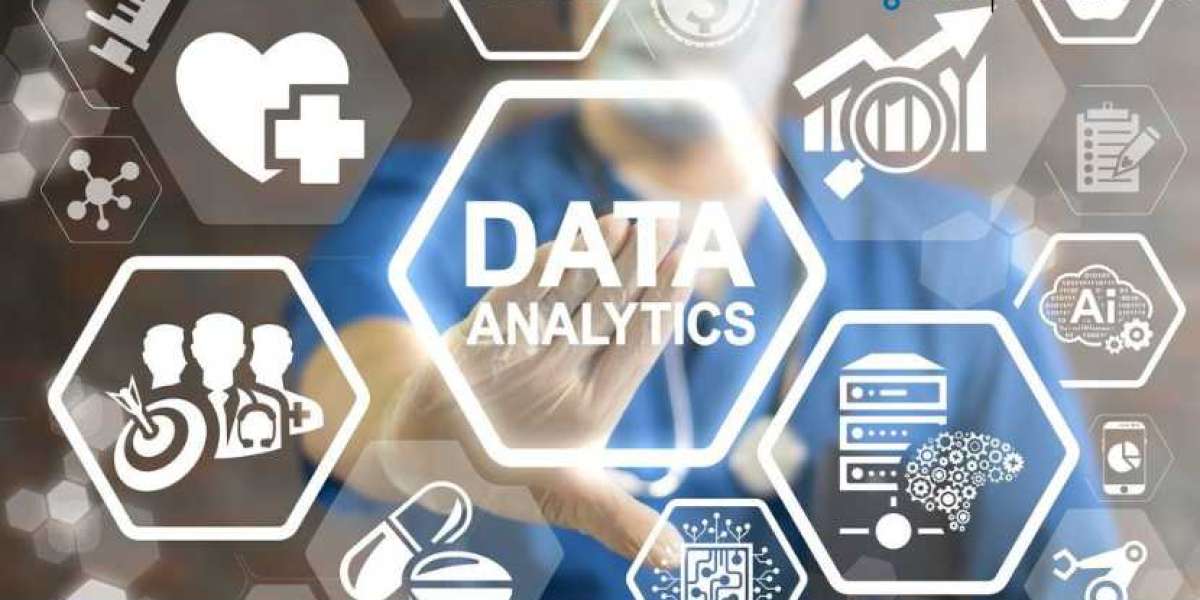I. Introduction
The clinical data analytics market in North America is a burgeoning field that leverages data to improve healthcare outcomes, enhance operational efficiency, and reduce costs. As of 2023, the market size was valued at USD 13.14 billion, and it is projected to grow at a robust CAGR of 9.9% to reach USD 32.01 billion by 2032. This growth is driven by technological advancements, increased data generation, and the rising need for better healthcare management and patient outcomes.
II. Market Drivers
Increasing Adoption of Electronic Health Records (EHRs)
EHRs have revolutionized the way patient data is stored, accessed, and analyzed. The transition from paper-based to digital records has facilitated the accumulation of vast amounts of patient data, which can be analyzed to improve clinical outcomes, streamline operations, and personalize patient care. Government mandates and incentives, such as the Health Information Technology for Economic and Clinical Health (HITECH) Act in the United States, have further accelerated the adoption of EHRs.
Rising Demand for Personalized Medicine
Personalized medicine, which tailors treatment to individual patients based on their genetic, environmental, and lifestyle factors, relies heavily on data analytics. By analyzing vast datasets, healthcare providers can identify trends and patterns that help predict how different patients will respond to treatments. This approach not only improves patient outcomes but also reduces healthcare costs by avoiding ineffective treatments.
Government Initiatives Promoting Data Analytics in Healthcare
Governments across North America are investing in healthcare IT infrastructure to promote the use of data analytics. Initiatives such as the Affordable Care Act (ACA) and the Precision Medicine Initiative in the U.S. are aimed at improving healthcare quality and patient outcomes through the use of data. These initiatives provide funding and incentives for healthcare providers to adopt advanced analytics tools.
Growing Volume of Healthcare Data
The amount of data generated in the healthcare sector is growing exponentially. This data comes from various sources, including EHRs, clinical trials, medical imaging, wearable devices, and genomic sequencing. The availability of such vast amounts of data presents an unprecedented opportunity to gain insights into disease patterns, treatment outcomes, and patient behaviors, which can be leveraged to improve healthcare delivery.
Advancements in Artificial Intelligence and Machine Learning
Artificial intelligence (AI) and machine learning (ML) are transforming clinical data analytics by enabling the analysis of large datasets at unprecedented speeds and accuracies. These technologies can identify patterns and correlations that would be impossible for humans to detect. Applications of AI and ML in healthcare include predictive analytics for disease outbreaks, personalized treatment plans, and automated diagnostic tools.
III. Market Restraints
High Costs Associated with Data Analytics Solutions
Implementing advanced data analytics solutions can be costly, involving significant investments in software, hardware, and skilled personnel. Smaller healthcare providers and institutions may find these costs prohibitive, limiting the widespread adoption of analytics tools. Additionally, the return on investment (ROI) can be uncertain, as the benefits of analytics are often realized over the long term.
Data Privacy and Security Concerns
Healthcare data is highly sensitive and subject to strict regulations, such as the Health Insurance Portability and Accountability Act (HIPAA) in the United States. Ensuring the privacy and security of patient data is a significant challenge, as breaches can result in severe penalties and loss of trust. The increasing use of cloud-based solutions and the growing threat of cyberattacks further exacerbate these concerns.
Lack of Skilled Professionals
The successful implementation of clinical data analytics requires a workforce with specialized skills in data science, statistics, and healthcare. There is currently a shortage of such professionals, which hampers the ability of healthcare organizations to fully leverage the benefits of data analytics. Training and education programs are needed to address this skills gap.
Integration Challenges with Existing Systems
Many healthcare organizations use legacy systems that are not designed to handle the volume and complexity of modern data analytics. Integrating new analytics tools with these existing systems can be challenging and costly. Data silos, where information is isolated in different departments or systems, further complicate integration efforts.
Get a Free Sample Report with Table of Contents
IV. Market Opportunities
Expansion of Telehealth and Remote Patient Monitoring
The COVID-19 pandemic has accelerated the adoption of telehealth and remote patient monitoring, generating vast amounts of data that can be analyzed to improve patient care. Analytics can be used to monitor patient health in real-time, predict potential health issues, and provide timely interventions. This expansion presents significant opportunities for growth in the clinical data analytics market.
Integration of Blockchain Technology for Enhanced Data Security
Blockchain technology offers a promising solution to data security concerns in healthcare. By providing a decentralized and immutable ledger, blockchain can enhance the security and integrity of patient data. The integration of blockchain with clinical data analytics can help address privacy concerns and build trust in data-sharing practices.
Development of Predictive Analytics for Disease Prevention
Predictive analytics uses historical data to forecast future outcomes, which can be particularly useful in disease prevention. By analyzing data on patient history, lifestyle, and genetic factors, predictive models can identify individuals at high risk of developing certain conditions and suggest preventive measures. This proactive approach can improve patient outcomes and reduce healthcare costs.
Increasing Investments in Healthcare IT Infrastructure
Governments and private investors are increasingly recognizing the importance of healthcare IT infrastructure in improving patient care and operational efficiency. Investments in advanced analytics tools, cloud computing, and data storage solutions are expected to drive market growth. These investments also support the development of new applications and technologies in clinical data analytics.
V. Market Segmentation
By Component
Software: Includes analytics platforms, data management tools, and visualization software that enable healthcare providers to analyze and interpret clinical data.
Services: Encompasses consulting, implementation, and training services that help healthcare organizations deploy and effectively use data analytics solutions.
By Deployment Model
On-premise: Solutions hosted on the healthcare provider's own servers, offering greater control over data and security but requiring significant upfront investments.
Cloud-based: Solutions hosted on remote servers, providing scalability, flexibility, and cost-effectiveness. Cloud-based models are increasingly popular due to their ease of implementation and maintenance.
By Application
Population Health Management: Uses data analytics to manage and improve the health outcomes of a specific population by identifying trends and providing targeted interventions.
Financial Analytics: Analyzes financial data to optimize revenue cycle management, reduce costs, and improve financial performance.
Clinical Analytics: Focuses on improving clinical outcomes through the analysis of patient data, including diagnostic and treatment information.
Operational and Administrative Analytics: Enhances operational efficiency by analyzing data related to healthcare administration, resource utilization, and workflow management.
By End User
Hospitals and Clinics: Primary users of clinical data analytics, leveraging data to improve patient care, streamline operations, and reduce costs.
Research Institutes: Use data analytics to conduct medical research, analyze clinical trials, and develop new treatments.
Insurance Companies: Utilize analytics to assess risk, optimize pricing, and improve claims management.
VI. Regional Analysis
United States
Market Size and Growth Projections: The U.S. is the largest market for clinical data analytics in North America, driven by advanced healthcare infrastructure and high adoption rates of EHRs and analytics tools.
Key Trends and Developments: Growing focus on value-based care, increasing use of AI and ML, and significant investments in healthcare IT.
Government Regulations and Policies: Policies like the HITECH Act and the ACA promote the use of data analytics to improve healthcare quality and reduce costs.
Canada
Market Size and Growth Projections: The Canadian market is also experiencing significant growth, supported by government initiatives and the increasing adoption of digital health technologies.
Key Trends and Developments: Emphasis on patient-centric care, increasing use of predictive analytics, and advancements in telehealth.
Government Regulations and Policies: Government programs and funding initiatives, such as the Canada Health Infoway, support the adoption of data analytics in healthcare.
VII. Competitive Landscape
Overview of Key Players
Altera Digital Health Inc.:
- Company Background: Leading provider of health IT solutions.
- Key Products and Services: EHR systems, data analytics platforms, and telehealth solutions.
- Recent Developments and Strategies: Focus on expanding product portfolio and strategic partnerships.
Oracle Corporation:
- Company Background: Global technology company specializing in database software and cloud solutions.
- Key Products and Services: Oracle Health Sciences, data analytics tools, and cloud-based solutions.
- Recent Developments and Strategies: Investment in AI and ML technologies, acquisitions to enhance healthcare offerings.
IBM Corp.:
- Company Background: Multinational technology company with a strong presence in healthcare analytics.
- Key Products and Services: IBM Watson Health, AI-driven analytics platforms, and cloud services.
- Recent Developments and Strategies: Focus on AI innovation, strategic collaborations, and expanding cloud capabilities.
Koninklijke Philips N.V.:
- Company Background: Dutch multinational company focused on health technology.
- Key Products and Services: Health informatics solutions, diagnostic imaging, and data analytics platforms.
- Recent Developments and Strategies: Emphasis on connected care, AI integration, and strategic acquisitions.
VIII. Key Trends and Developments
Adoption of Advanced Analytics Tools
The healthcare industry is increasingly adopting advanced analytics tools, such as AI and ML, to derive actionable insights from complex datasets. These tools enhance diagnostic accuracy, predict patient outcomes, and optimize treatment plans.
Collaboration and Partnerships Among Market Players
Collaborations and partnerships are becoming common as companies seek to leverage each other's strengths. For example, tech companies partner with healthcare providers to develop tailored analytics solutions, while research institutions collaborate with analytics firms for clinical trials.
Focus on Real-time Data Analytics
Real-time data analytics is gaining traction as it enables healthcare providers to make timely decisions based on up-to-date information. Applications include real-time patient monitoring, rapid diagnostic processes, and immediate interventions.
Emergence of Big Data Analytics in Healthcare
Big data analytics involves analyzing large volumes of diverse healthcare data to uncover hidden patterns and correlations. This approach is used in population health management, personalized medicine, and operational efficiency improvements.
IX. Impact of COVID-19
Changes in Healthcare Data Analytics Due to the Pandemic
The COVID-19 pandemic has highlighted the importance of data analytics in managing public health crises. Analytics has been used to track the spread of the virus, predict outbreaks, and allocate resources effectively.
Increased Focus on Predictive Analytics for Managing Pandemics
Predictive analytics played a crucial role during the pandemic by forecasting infection rates, identifying high-risk populations, and informing public health strategies. The success of these efforts is likely to drive further investment in predictive analytics.
Long-term Impacts on Market Growth
The pandemic has accelerated the adoption of digital health technologies, including data analytics. This shift is expected to have long-term positive effects on market growth as healthcare providers continue to invest in analytics capabilities.
X. Future Outlook
Market Growth Projections and Future Trends
The clinical data analytics market in North America is poised for significant growth, driven by technological advancements, increasing data generation, and rising demand for personalized medicine. Future trends include the integration of AI and ML, the use of blockchain for data security, and the expansion of telehealth.
Emerging Technologies and Their Impact
Emerging technologies, such as quantum computing and augmented reality, have the potential to further revolutionize clinical data analytics. These technologies can enhance data processing speeds, improve visualization capabilities, and provide new insights into complex healthcare data.
Potential Challenges and Solutions
Challenges such as data privacy concerns, high costs, and a shortage of skilled professionals need to be addressed to fully realize the potential of clinical data analytics. Solutions include investing in cybersecurity, developing cost-effective analytics tools, and enhancing education and training programs.








